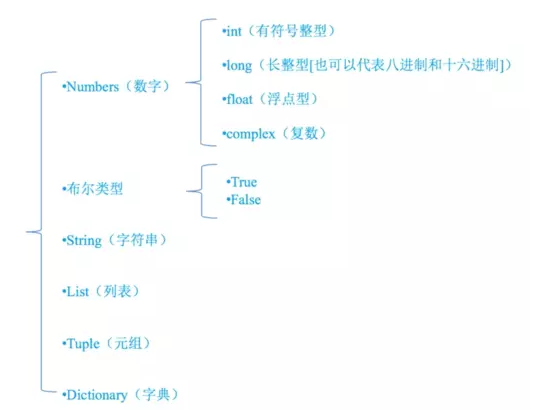您好,登錄后才能下訂單哦!
您好,登錄后才能下訂單哦!
了解python基礎知識示例?這個問題可能是我們日常學習或工作經常見到的。希望通過這個問題能讓你收獲頗深。下面是小編給大家帶來的參考內容,讓我們一起來看看吧!
python內置的數據類型

Python3.7內置的關鍵字
['False', 'None', 'True', 'and', 'as', 'assert', 'async', 'await', 'break', 'class', 'continue', 'def', 'del', 'elif', 'else', 'except', 'finally', 'for', 'from', 'global', 'if', 'import', 'in', 'is', 'lambda', 'nonlocal', 'not', 'or', 'pass', 'raise', 'return', 'try', 'while', 'with', 'yield']
格式化輸出
A = 'dog'
print('It is a %s' % A ) # --> It is a dog
# 格式符可以是 %d整數 %f浮點數
print('%06d'% 1111) #-->001111 # 拿0補全6位,不寫0就是拿空格補全6位
print('%.3f' %1.2) #-->1.200 # 保留3位小數
print('It is a {}'.format(A) ) # --> It is a dog關于format函數還可以設置參數,傳遞對象:format多種用法
邏輯運算符優先級and or not
當not和and及or在一起運算時,優先級為是not>and>or
字符串常見操作
find
檢測 str 是否包含在 mystr中,如果是返回開始的索引值,否則返回-1
mystr.find(str, start=0, end=len(mystr))
index
跟find()方法一樣,只不過如果str不在 mystr中會報一個異常.
mystr.index(str, start=0, end=len(mystr))
count
返回 str在start和end之間 在 mystr里面出現的次數
mystr.count(str, start=0, end=len(mystr))
replace
把 mystr 中的 str1 替換成 str2,如果 count 指定,則替換不超過 count 次.
mystr.replace(str1, str2, mystr.count(str1))
split
以 str 為分隔符切片 mystr,如果 maxsplit有指定值,則僅分隔 maxsplit 個子字符串
mystr.split(str=" ", 2)
capitalize
把字符串的第一個字符大寫
mystr.capitalize()
title
把字符串的每個單詞首字母大寫
>>> a = "hello world" >>> a.title() 'Hello world'
startswith
檢查字符串是否是以 hello 開頭, 是則返回 True,否則返回 False
mystr.startswith(hello)
endswith
檢查字符串是否以obj結束,如果是返回True,否則返回 False.
mystr.endswith('.jpg')lower
轉換 mystr 中所有大寫字符為小寫
mystr.lower()
upper
轉換 mystr 中的小寫字母為大寫
mystr.upper()
ljust
返回一個原字符串左對齊,并使用空格填充至長度 width 的新字符串
mystr.ljust(width)
rjust
返回一個原字符串右對齊,并使用空格填充至長度 width 的新字符串
mystr.rjust(width)
center
返回一個原字符串居中,并使用空格填充至長度 width 的新字符串
mystr.center(width)
lstrip
刪除 mystr 左邊的空白字符
mystr.lstrip()
rstrip
刪除 mystr 字符串末尾的空白字符
mystr.rstrip()
strip
刪除mystr字符串兩端的空白字符
>>> a = "\n\t hello \t\n" >>> a.strip() 'hello '
字典
查找元素
a = {'a':1}
print(a.setdefault('b', 2)) # --> 2 # 找不添加到字典中
print(a.get('c')) # --> None # 找不到不報錯
print(a) # --> {'a': 1, 'b': 2}刪除元素
a = {'a': 1, 'b': 2}
del a['a'] # 刪除指定key
del a # 刪除整個字典在內存里清除
clear a # 清空字典,a={}字典常見操作
dict.len()
測量字典中,鍵值對的個數
dict.keys()
返回一個包含字典所有KEY的列表
dict.values()
返回一個包含字典所有value的列表
dict.items()
返回一個包含所有(鍵,值)元祖的列表
python內置函數
max() 返回最大元素
min() 返回最小元素
len(容器)
del(變量) 刪除變量
map(function, iterable, ...)
根據提供的函數對指定序列做映射
reduce(function, iterable[, initializer]) # initializer是初始參數
對參數序列中元素進行累積
filter(function, iterable)
用于過濾序列,過濾掉不符合條件的元素,返回由符合條件元素組成的迭代器對象(py3)。py2返回列表。
感謝各位的閱讀!看完上述內容,你們對python基礎知識示例大概了解了嗎?希望文章內容對大家有所幫助。如果想了解更多相關文章內容,歡迎關注億速云行業資訊頻道。
免責聲明:本站發布的內容(圖片、視頻和文字)以原創、轉載和分享為主,文章觀點不代表本網站立場,如果涉及侵權請聯系站長郵箱:is@yisu.com進行舉報,并提供相關證據,一經查實,將立刻刪除涉嫌侵權內容。